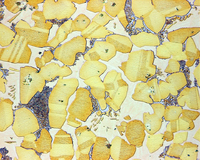
Photo from wikipedia
Abstract Gas-atomized powders of two ternary alloys, Al-3.60Mg-1.18Zr and Al-3.66Mg-1.57Zr (wt.%), were densified via laser powder bed fusion. At energy densities ranging from 123 to 247 J/mm3, as-fabricated components are near-fully… Click to show full abstract
Abstract Gas-atomized powders of two ternary alloys, Al-3.60Mg-1.18Zr and Al-3.66Mg-1.57Zr (wt.%), were densified via laser powder bed fusion. At energy densities ranging from 123 to 247 J/mm3, as-fabricated components are near-fully densified (relative density 99.2–99.9%) as verified by X-ray tomography. While Mg acts a solid-solution strengthener, Zr creates two types of metastable L12 Al3Zr precipitates, each playing dual roles: (a) sub-micrometer Al3Zr particles form in the melt upon solidification and act as grain refining agents, nucleating fine aluminum grains, which (i) prevent hot-tearing during the rapid solidification inherent to laser melting and (ii) enhance tensile strength (Hall-Petch strengthening) and ductility (influence a heterogenous grain structure) after fabrication; (b) Al3Zr nano-precipitates form in the solid alloy during subsequent aging, which (i) precipitation-strengthen the alloy leading to an increase of >40% in strength over the as-fabricated value, and (ii) promote thermal stability of the fine grain size (and the associated Hall-Petch strengthening) after exposure to high temperature due to the slow kinetics of Al3Zr coarsening (from the sluggish diffusivity of Zr in solid Al-Mg). While the Zr-richer alloy shows higher yield and ultimate tensile strength in the as-fabricated state, both alloys have identical mechanical properties after peak aging. Interconnected bands of fine (∼0.8 μm), equiaxed, isotropic grains and coarser (∼1 × 10 μm), columnar, textured grains – both containing oxide particles and Al3Zr precipitates - provide a combination of high yield strength and high ductility (e.g., ∼354 MPa, and ∼20%, respectively) with isotropic values in both as-fabricated and peak-aged samples, unlike Al-Si alloys processed via laser fusion of commercial Al-Si-based powders. The pre-alloyed, gas-atomized Al-Mg-Zr powders do not contain expensive alloying elements such as Sc, nor do they require blending with a second powder to nucleate fine grains, making them excellent candidates for economical, large-scale additive manufacturing applications.
Journal Title: Acta Materialia
Year Published: 2018
Link to full text (if available)
Share on Social Media: Sign Up to like & get
recommendations!